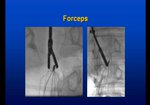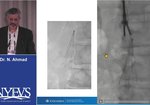Playback speed
10 seconds
1,936 views
February 27, 2013
Percutaneous retrieval of an intravascular foreign body
INDICATIONS
▪ Intravascular central venous catheter fragments
▪ ...
read more ↘ Incorrect stent position
▪ Dislocated embolization coils
▪ Guidewires and vena cava filters predisposed to cause perforating injuries to the vascular wall
▪ Any intravascular foreign body posing a risk of serious sequelae (infection, embolism, thrombosis, arrhythmia, and vessel injury)
CONTRAINDICATIONS
▪ No general contraindications for foreign-body removal have been noted.
▪ Every case is a particular case in which the benefit of the procedure is weighed against the risk associated with the maneuver.
▪ Relative contraindication in case of migrated stents into the pulmonary artery; given that stents remain patent, the need to intervene is questionable.
↖ read less
INDICATIONS
▪ Intravascular central venous catheter fragments
▪ ...
read more ↘ Incorrect stent position
▪ Dislocated embolization coils
▪ Guidewires and vena cava filters predisposed to cause perforating injuries to the vascular wall
▪ Any intravascular foreign body posing a risk of serious sequelae (infection, embolism, thrombosis, arrhythmia, and vessel injury)
CONTRAINDICATIONS
▪ No general contraindications for foreign-body removal have been noted.
▪ Every case is a particular case in which the benefit of the procedure is weighed against the risk associated with the maneuver.
▪ Relative contraindication in case of migrated stents into the pulmonary artery; given that stents remain patent, the need to intervene is questionable.
↖ read less
Comments 8
Login to view comments.
Click here to Login



















